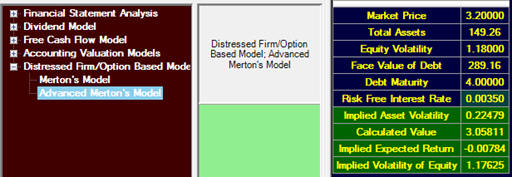10.6 The Extended Merton Model
In the extended
Merton model, the asset volatility is replaced as an input by the
equity volatility. The
relationship between the two volatilities is:

Given the
equity volatility, we can try and solve this equation for the asset
volatility. Note,
however, that a solution does not always exist; if it does
not, then Valuation Tutor responds with “N/A” in its calculated
fields.
The standard
Merton Model above already tells you the equity volatility needed to
match the asset volatility; is 3.48221 in the example we just
completed. But that is
not the point; we want the equity volatility to be the input and see
what the resulting asset volatility and stock price are.
We calculated
the historical volatility of GM in 2008 using daily data for the
year; the equity volatility was 118%.
Entering this into the advanced Merton model yields:

This has an
implied asset volatility of about 51%, which is much lower than the
65% needed to match the stock price.
But this is to be expected; we have assumed that the entire
debt of GM is due to be paid within 6 months.
A more detailed analysis would look at the structure of the
liabilities and determine what the appropriate time period is.
For example, if we assume the debt is to be paid off in four
years, the values match the prices of GM quite closely:

